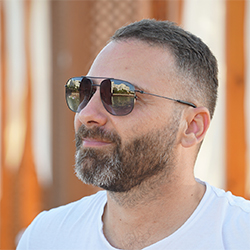Crete Historical Sites, Landmarks, Fortresses and Points of Interest
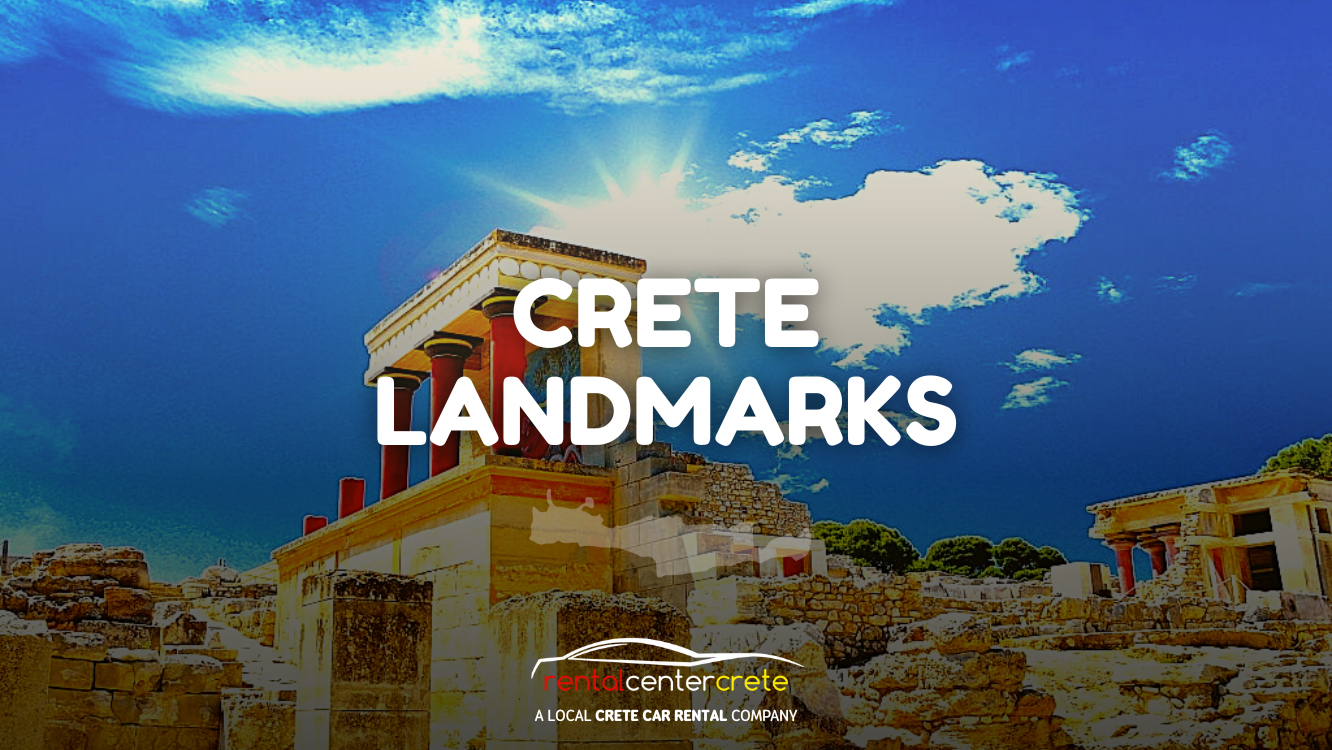
The island of Crete is not just a beautiful holiday destination. It is one of the richest cultures and landmarks. There are many archaeological sites on the island of Crete. Crete is the largest and most populous island in Greece. The island of Crete is mostly mountainous, and its character is defined by a high mountain range crossing from west to east. It is located in the southern part of the Aegean Sea, separating the Aegean from the Libyan Sea.
The beautiful island of Crete has several gorges and valleys. The island has numerous archaeological sites. Tourists will never get enough of how rich the culture and history of the island are. Crete Archaeological Sites include the Minoan sites of Knossos, Malia, Petras and Phaistos, the classical site of Gortys, and the island of Koufonisi. When visiting Crete, one must include in their itinerary the Crete history sites. These include the Spinalonga, The Palace of Knossos, Lebena ruins and The Arkadi Monastery among many others. One must not also forget Crete famous landmarks and Ancient Greece Landmarks in Crete.
Crete has several famous landmarks that one can easily recognise. A landmark is a feature of a town or landscape that is easily recognised even from afar. Mount Ida is a famous landmark in Crete. It is the highest mountain in Crete. It is often called the “Mountain of the Goddess”. Another prominent landmark in Crete is the Hania Fortifications. It is a defensive wall that surrounds the city of Chania in Crete. Some of its parts were abolished in the 20th century, but there are still some remaining parts of the wall. The Spinalonga Castle is also a beautiful landmark in Crete. It is included in the UNESCO World Heritage Site. It is famous for its pebbled beaches and clear waters.
One way to understand the true beauty of a place is by knowing its history. Crete is one example of a majestic island with a rich history, landmarks, and archaeological sites. It is a must-visit place where one can do outdoor adventures and mind-enriching activities like visiting museums and archaeological sites. The island of Crete has a lot to offer, and it is the best holiday destination for people who love history and the ancient way of living. One will never run out of things to do when on Crete. Going around different places is easier because there is regular transportation on the island.
Listed below are the three famous Landmarks in Crete.
- Knossos and Minoan Sites. The Palace of Knossos was known to have been built during the start of the Minoan period. It is known to be a religious ceremonial place. The palace was built with carved structures and designed with colourful murals.
- Mount Ida / Mount Psiloritis. The famous Mount Ida is one of the most impressive of all landmarks in Crete. It is home to the Ideon Cave, which, traditions say, is where the Greek God Zeus was reared.
- Lebena Ruins. Located on the outskirts of the village of Lendas, the archaeological site started as a famous health spa. The water is known to be therapeutic. Very little remains of the original structure. There are also some intricately laid mosaic floors visible in the ruins.
1. Knossos and Minoan Sites
Knossos or sometimes spelt as Cnossus, is an ancient city in Crete, the capital of the legendary King Minos, and the main centre of the Minoan, the earliest of the Aegean civilisations. The site of Knossos is on a knoll between the junctions of two rivers, located about 5 miles inland from Crete’s northern coast. The first palace at Knossos was built at the start of the Middle Minoan period (2000-1580 BC). It has isolated structures built around a rectangular court. Heraklion, also known as Iraklio, is a port city and the capital of the island of Crete. It is famous for the Palace of Knossos, outside the city. The archaeological site of Knossos Palace is about 20,000 square metres (23,919 yd²) and has over 1,500 rooms. A good two-hour visit to the Knossos Palace will provide a greater understanding of the ancient Greeks during those times. The tour will require a lot of walking, so one must have comfortable shoes and clothing.
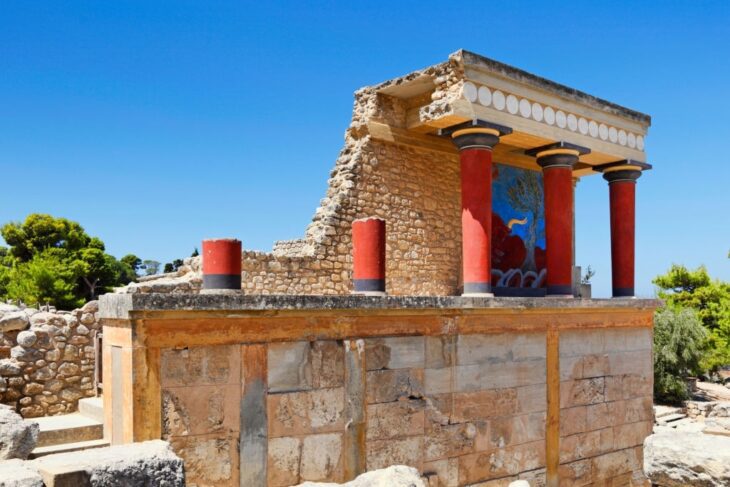
The most significant part of the site is the Great Palace. Its wings are placed around a central courtyard. Inside it are the royal quarters, shrines, workshops, repositories, banquet halls, and store rooms. In the house of the High Priest, a stone altar was found, and it is surrounded by double axe swords. At both Knossos and Malia, there are pillar crypts in ground-floor rooms. The pillar crypt is considered by some as a cult area in which rites designed to calm such destructive divinity were conducted. The archaeological site of Knossos is easy to access. It is just a 15-minute car drive or takes a bus from the bus station at the Heraklion port. Public buses are affordable. When one is travelling from Chania, the duration will take about 2 to 3 hours. The route runs along the northern coast of Crete. On the way, there is an option of stopping in Rethymno, a well-visited port city. One can take a route that leads to Minoan Palace at Knossos. It’s called the “Royal Road”. The “Royal Road” is also called the oldest road in Europe.
2. Mount Ida (Psiloritis)
Mount Ida or Mount Idi is the highest mountain on the island of Crete. It has an elevation of 2.456 metres (8.057 feet). Mount Ida is a natural park and is a member of UNESCO’s Global Geoparks Network. Mount Ida has the highest topographic prominence of any mountain in Greece. Furthermore, Mount Ida in Crete is the island’s highest summit and is sacred to the Goddess Rhea. Visitors who love Greek Mythology will enjoy a tour of the famous Mount Ida.
3. Lebena Ruins
The Lebena Ruins are located at the southern foot of the Asterousia mountains, on the shore where the village of Lendas is located. It was first inhabited during the Final Neolithic years. There are many archaeological finds in the Lebena ruins, which is dated from 3.000 years ago, including tombs from the Proto-minoan graves. There used to be a therapeutic thermal spring in the area, famous for hydrotherapy during those times. The Lebena Ruins in Crete are also a great spot for hikers.
4. Rethymno Fortress and Acropolis
The fortress, also known as Fortezza, is the citadel of the city of Rethymno in Crete. It is situated on a hill which was the site of ancient Rithymna’s acropolis. During the 10th and 13th centuries, the Byzantines built a fortified settlement to the east of the hill. It was called Castrum Rethemi or Rethymno Fortress, and it had 2 square towers and 2 gates. By the beginning of the 20th century, numerous houses were built within the citadel. These houses were demolished after World War II, and only a few historic buildings remain.
5. Arkadi Monastery
The Arkadi Monastery is located in the southeast of Rethymnon, on the island of Crete. It is an Eastern Orthodox monastery. The Arkadi Monastery played a significant role in the history of Cretan resistance to Ottoman rule during the Cretan revolt of 1866. According to tradition, the monastery was founded by a monk called Arcadius. The area where the monastery is located was first developed in ancient times. One must visit the historical monastery to understand the rich history of Crete and how they fought for their independence. The monastery is situated on a rectangular, lush plateau on the northwest side of Mount Ida in Crete.
7. Hania Fortifications
Hania Fortifications or Chania Fortifications are a series of defensive that which surround the city of Chania in Crete. The main city walls were first built in antiquity, and then later rebuilt by the Byzantine Empire. The Republic of Venice built the outer walls in the 16th century. Parts of the Byzantine and Venetian walls remain intact, while some fortifications were demolished in the 20th century. The Chania fortifications were roughly square. The walls were up to 66 ft high. Key bastions—San Salvatore, San Dimitrio, Santa Lucia, and Mocenigo—reinforced the walls. Three main gates—Porta San Salvatore, Porta Retimiota, and Porta Sabbionara—operated from sunrise to sunset.
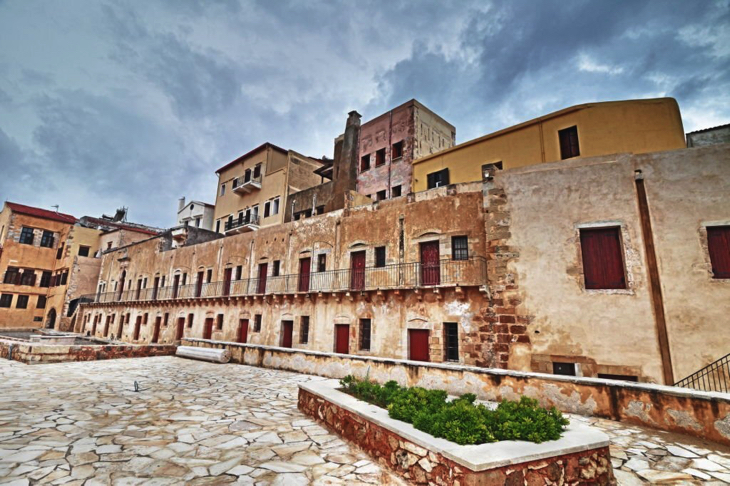
The history of Hania Fortifications in Chania, Crete, began with the Byzantine Empire, which reinforced and expanded the original wall established by the ancient city of Cydonia during the 6th and 7th centuries. The Byzantines later reclaimed the city, constructing a new fortress on the hill of Kastelli. In the 13th century, under Venetian rule, additional fortifications were built due to the rising Ottoman threat. During the Ottoman-Venetian War, the Ottomans besieged Chania and, after breaching the defenses, restored the damaged walls. In the early 20th century, the Cretan State demolished parts of the southern walls to allow city expansion.
8. Lato Ancient City
Lato was an ancient city in Crete. The ruins are located 3 kilometres (1.9 miles) from the village of Kritsa. Lato Ancient City is one of the best excavated Greek cities on the island of Crete. The town centre is at the top of the hill. Lato Etera became an important city during Roman times. The area owes its name to the goddess Lito or Lato, who was the mother of Apollo and Artemis. The walls and buildings are still visible today. One famous landmark is The Agora of Lato in Crete.
9. Spinalonga Castle
The Spinalonga Castle is one of the UNESCO World Heritage Sites. It is located in the Gulf of Elounda in north-eastern Crete. One of the strongest fortresses on the island by the Venetians. Spinalonga may be the only castle in Greece where its modern history is far more interesting. The strategic location of the fortress protects the bay of Elounda, an important part of the Venetian sea trade. The name of the island came from the Latin words “Spina” and “lunga”. Today, the island is a popular tourist attraction in Crete. Spinalonga in Crete, is known for its pebbled dainty beaches and shallow waters.
10. Archanes Village
Archanes is a scenic village built on the slopes of Mount Giouchtas, 15 km (9,32 miles) south of Heraklion. Located in the heart of the most significant wine-producing region of Crete. It has a rich history dating back 5000 years ago. The village is popular for its typical Cretan architecture. It is also the archaeological site of an ancient Minoan settlement in Central Crete. Archaeological evidence shows that ancient Archanes spread out over the same area as the modern village of Archanes. The Archanes Village in Crete, has old houses recently restored and won second place as the “best-restored village in Europe”.
11. Samaria Gorge
Samaria Gorge is one of the most scenic national parks in Europe. The Samaria Gorge stretches more than 16.09 kilometres (10 miles) into the southern coastal region. Samaria Gorge National Park in Crete has been Greece’s National Park since 1962. It is located on the island of Crete, a famous tourist attraction of the island, and a World Biosphere Reserve. It offers many hiking trails for tourists and locals. The village of Samaria lies inside the gorge. The Samaria gorge is one of the favourite places to visit for tourists in Crete.
12. Heraklion
Heraklion is the largest city and the administrative capital of Crete. It is Heraklion’s capital regional unit. Heraklion lies on the north coast of the island along the Sea of Crete, and northwest of the ancient Minoan capital of Knossos. Its name derives from the ancient Roman port of Heraklion. Most of the extensive system of walls was built around the city by Venetian survivors. During World War II, the city suffered major damage from the bombing. Today, Heraklion Town is one of the busiest city centres in Crete. In the Heraklion region, there are two important Crete monuments to be found. The Knossos Palace in Crete and Phaistos Palace.
13. Preveli Monastery
The jewel of South Crete, the Preveli monastery. It consists of two main building complexes, the Lower Monastery of Saint John the Baptist and the Rear (Piso) Monastery of Saint John the Theologian, which is in operation today. The oldest date related to the monastery was 1594. It is also engraved on the bell of the monastery. The Preveli monastery was among the numerous churches destroyed when the Turks occupied Crete in 1649. The Rear Preveli Monastery in Crete is located at the foot of a mountain overlooking the blue Libyan sea.
14. Windmills of Lassithi
The Windmills of Lassithi stand on the Lassithi Plateau in eastern Crete, a fertile 25-square-kilometre area framed by the Dikti Mountains to the north and the Selena Mountains to the south. At an elevation of around 800 metres above sea level, the plateau provides an ideal vantage point for capturing the region’s strong winds. The windmills are strategically positioned to leverage the topography and consistent wind patterns, maximising energy capture.
The Lassithi Plateau has long utilised wind power through its iconic windmills, aided by its high elevation and favourable wind conditions. This area, with its panoramic views and natural surroundings, captivates visitors, highlighting its historical and cultural significance in Crete. The Windmills of Lassithi have become landmarks, symbolising the blend of traditional practices with sustainable energy in a scenic setting.
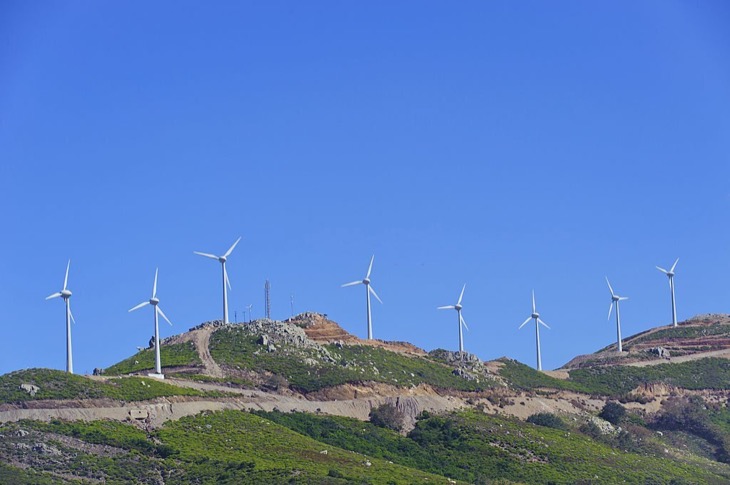
The Windmills of Lassithi supply electricity primarily to the Lassithi Plateau, where local residences, businesses, and infrastructure benefit from this clean energy source. Tzermiado, a major settlement on the plateau, relies on wind-generated electricity to meet its residential and commercial needs. Agios Georgios, another historical community, also gains from this sustainable energy, promoting eco-friendly practices in the region. Additionally, several smaller villages nearby are likely connected to the plateau’s renewable energy system, collectively supporting the region’s demand for sustainable power.
The Windmills of Lassithi were initially constructed in 1464 by Venetian engineers, marking the beginning of wind-powered infrastructure in the region. Locally built windmills started appearing toward the end of the 1800s, addressing agricultural needs for grain milling and water pumping on the fertile but water-scarce Lassithi Plateau.
The Lassithi Plateau once hosted between 10,000 and 20,000 windmills at peak operation, though many were later abandoned due to technological progress, shifts in agriculture, and urbanisation. Approximately 20 to 25 restored and operational windmills remain today, maintained for power generation, cultural preservation, and tourism purposes.
The decline in windmills reflects shifts in agricultural and energy practices, alongside efforts to preserve historical landmarks. The remaining windmills serve as reminders of the region’s past and underscore the importance of safeguarding cultural heritage for future generations. Fewer than 5,000 windmills remain, with most abandoned in favour of modern diesel and electric pumps.
15. Minoan Palace of Zakros
The Minoan Palace of Zakros, one of Crete’s four main Minoan palaces occupies the island’s easternmost point and was a key center for trade and commerce in ancient times. Zakros Palace is located in Kato Zakros, 45 kilometers (28 miles) from Sitia, it rests among rocky hills with mountains to the east. Visitors can reach the site by car from Sitia in 58 minutes or from Agios Nikolaos in 2.5 hours, and there is bus service from Sitia to Kato Zakros village.
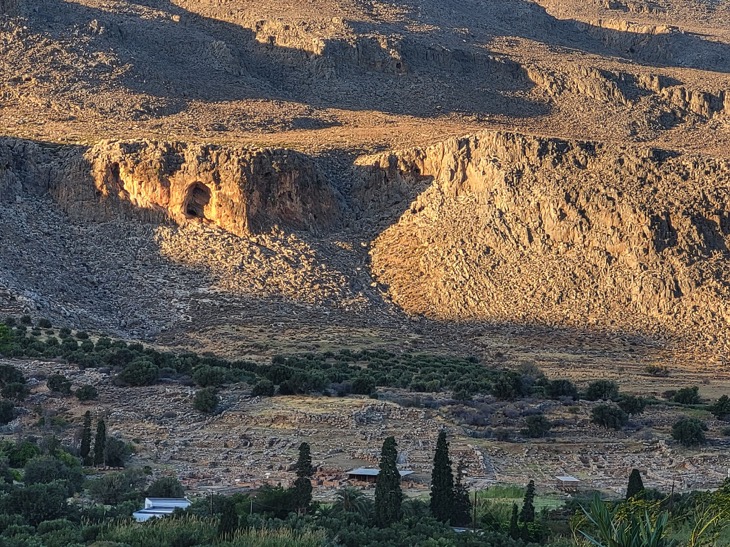
The Palace of Zakros, built around 1600 BC, served as a crucial administrative, commercial, and religious center in Crete, acting as an important trade link with Egypt, Cyprus, and the Middle East due to its strategic coastal location. The palace spans 8,000 square meters (86,111 square feet) and contains 150 rooms, a central court, an advanced drainage system, and workshops. Noteworthy features include the “House of the Frescoes”, with intricate wall paintings, and rock-carved burial chambers. Excavations by D.G. Howarth and later by Nikolaos Platon in 1961 uncovered significant artifacts, such as elephant tusks, bronze ingots, and Canaanite jars, offering valuable insights into its cultural and trade connections.
The Minoan Palace of Zakros is open to visitors daily from 8:00 to 15:00, with entrance fees of 6 € ($6.40, £5.20) for regular tickets and 3.5 € ($3.75, £3) for reduced tickets. Early morning visits are recommended to avoid peak heat and crowds, especially during spring and fall. Nearby, Kato Zakros village provides amenities like traditional tavernas, beaches, and beachfront accommodations. Additional attractions include the “Gorge of the Dead”, nearby Minoan town ruins, ancient harbor remains, and natural freshwater wells.
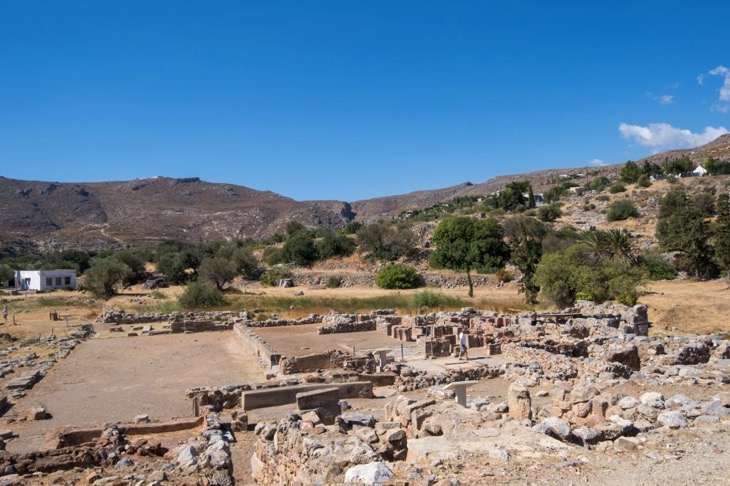
Visitors to the Minoan Palace of Zakros have multiple transportation options, including car rentals (recommended for flexibility), public transportation, and taxi services.
To reach the Palace of Zakros, begin by traveling to Heraklion, Crete, via plane, ferry, or car, depending on your starting location. Upon arrival, head to Heraklion Port or Heraklion International Airport, the city’s main transportation hubs. From Heraklion to Zakros Palace, options include:
- Rental Car: Rent a car to travel at your own pace; use navigation or follow signs toward Minoan Palace of Zakros.
- Public Bus: Take a KTEL Crete bus from the main bus station to the Palace of Knossos. Check schedules for route details.
- Taxi: Hire a taxi for a direct, convenient ride to the palace from any transportation hub.
What are the routes to visit Crete Historical Sites?
Listed below are the 5 main routes to visit Crete Historical Sites.
- Route 1. Chania to Chora Sfakion

One of the famous routes for driving in Crete is from Chania to Chora Sfakion. The route starts on the main national road VOAK/E75/EO90 that connects Chania to Rethymnon and beyond, following the north coast. When travelling this route, one may pass through some of the loveliest Cretan villages. Back at the coast, the beachside villages of Aptera and Kalyves can be seen before going off track again towards Vrysses, still on the national road. This is the midpoint of the route. Upon reaching Vrysses, turn off the national road and onto the rural route (“EO” or Epar. Od.”) “Vryson-Chora Sfakion”, heading south. The roads will lead next to Imbros, the entrance to the famous Imbros Gorge. A few kilometres south of Imbros, the road becomes more challenging and each offers a fabulous view of the Libyan sea far below. - Route 2. Chania to Elafonissi

When heading to Elafonissi, one of the most famous beaches in the world. There is a route from Chania. Follow the national coastal road Kissamos-Chania VOAK/E65/EO90, then turn south to cross through the interior. For the shorter route, turn at Drapanias to the country road Kaloudianon-Chrisoskalitissa. For the longer route, turn at Tavronitis (just past Meleme) onto the rural route (“EO” or Epar. Od”) Tavronitis-Paleochoras, look for signs for Paleochora. The slightly longer route will lead to the village of Ano Vouves, famous for its olive tree. The Mesavlia, where the Mesavia-Delaian gorge starts, will be passed through. This 5 km gorge connects the two villages. The two routes converge again before Elos, one of the prettiest villages on the route, where one can see a 14th-century Byzantine church. Just 5 km before reaching Elfanissis, one will pass the 17th Chrisoskalitissa Monastery. - Route 3. Chania to Therisos

The route from Chania to Therisos is one of the most half-hour drives one must take. Leaving Chania town towards the southwest of Vasiliou Poulaka, one will pass through the neighbourhood called Perivolia. Just follow the road signs to Theriso which leads to a narrow, steep-sided gorge. The gorge ends in Theriso, a very historic village. - Route 4. Rethymnon to Matala

This route starts from the beautiful Rethymno. The lovely destination is one of Crete’s well-known beaches, Matala. The rural route (“EO” or Epar. Od”) Rethymnou-Agias Galinis is a majestic beauty. The highlight along the road is the vast mountain village of Spili. About 10 km further onwards, the dainty village of Akoumia will be reached. Tourists can make another stop if they wish to visit the 14th-century Sotirias Christos church in the shady village square, and then the Agaia Galini’s gorgeous south coast will be reached. Continue from there to the rural route Faistou-Agias (‘EO or Epar. Od’) Timpakiou-Kamilariou, and afterwards, turn on to the rural route (“EO’ ‘ or “Epar. Od”) Gortinas-matalon. - Route 5. Sitia to Ierapetra, The Coastal Route
 The route will start in the lovely town of Sitia, and set off on the rural route (“EO” or “Epar. Od ”) Sitias-Palekastrou towards the east along the sea. From here, take a 12 km detour to Vai, a famous beach with clear waters and fine sands. Passing through Palekastro, will lead to Ano Zakros. From there, along the rural route (”EO” or “Epar. Od”) Zirou-Palaikastrou, the road rises again, giving way to vistas of the Libyan sea afar. After passing Ziros, the route will lead to Chandras, a small village of stone houses. Descending towards the southern coast, the Libyan sea will be visible again in dramatic view. The area around Ierapetra is the market basket of Greece.
The route will start in the lovely town of Sitia, and set off on the rural route (“EO” or “Epar. Od ”) Sitias-Palekastrou towards the east along the sea. From here, take a 12 km detour to Vai, a famous beach with clear waters and fine sands. Passing through Palekastro, will lead to Ano Zakros. From there, along the rural route (”EO” or “Epar. Od”) Zirou-Palaikastrou, the road rises again, giving way to vistas of the Libyan sea afar. After passing Ziros, the route will lead to Chandras, a small village of stone houses. Descending towards the southern coast, the Libyan sea will be visible again in dramatic view. The area around Ierapetra is the market basket of Greece.
What are the fortresses of Crete?
Crete’s landscape features impressive fortresses and castles, reflecting its rich military and cultural past. These structures, mostly from the Venetian period, were built to defend against threats like pirates and Ottoman invasions. Gramvoussa Fortress, situated 137 meters (449 feet) above sea level, became notorious as “Pirate Island” when 3,000 rebels used it in 1825. Frangokastello in Chania, famous for its “Drosoulites” or shadow warriors, symbolizes resistance against Turkish forces in 1828. Rethymnon’s Fortezza showcases a star-shaped design, built to withstand Turkish attacks but fell to the Ottomans in 1646. Coastal defenses like the Koules Fortress in Heraklion and Kales Fortress in Ierapetra further illustrate Crete’s defensive strategy.
1. Gramvoussa Fortress
Gramvousa Fortress, a Venetian castle on Imeri Gramvousa island off Crete’s northwest coast near Kissamos, sits 137 metres above sea level. Accessible only by boat from Kissamos, visits include Balos Beach. The fortress, located on a steep hill, requires navigating a narrow, winding path on its eastern side for access.
Gramvousa fortress was built by the Venetians between 1579 and 1584 to protect northeastern Crete and control the strait between Western Crete and Peloponnese. Although it could house 3,000 men, it saw no use in major Venetian battles. In 1692, Ottoman forces gained control of the fortress after bribing the Venetian commander, Luca Della Rocca. The Ottomans fortified it with 66 long-range cannons and stationed strong troops.
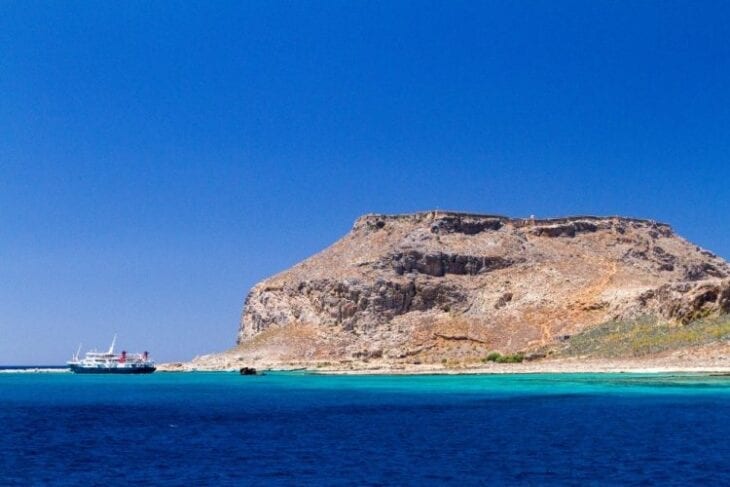
During the Greek War of Independence, the fortress acquired a reputation as “Pirate Island.” In 1825, Cretan rebels captured it, making it the first liberated part of Crete. However, food shortages drove the 3,000 inhabitants to piracy until British and French forces ended the occupation in 1828.
Gramvousa fortress earned a colourful history during the Greek War of Independence. In 1825, Cretan rebels captured it, marking it as the first liberated part of Crete. Food shortages forced its 3,000 inhabitants into piracy, earning it the nickname “Pirate Island”. This period ended in 1828 when British and French forces intervened.
The fortress exhibits a triangular layout with walls exceeding one kilometre in length. It includes two large underground water cisterns, the Church of the Annunciation (Panagia Kleftrina), a former powder storehouse later converted into a mosque, and the foundations of barracks and command posts.
Visiting Gramvousa Fortress requires a paid entry and is accessible only via organised boat tours from Kissamos, which also stop at Balos Beach. The best time to visit is during summer, with morning tours recommended to avoid midday heat on the steep ascent. Due to its remote location on an uninhabited Gramvousa island, visitors should bring water, sun protection, and sturdy shoes. There are no permanent facilities, restaurants, or cafes on Gramvousa island, though the semi-sunken motor ship “DIMITRIOS P” near the port offers a popular photography spot.
Gramvousa is a NATURA-protected area, supporting over 100 bird species and providing breeding grounds for Mediterranean seals and caretta caretta turtles. Visitors should allocate 90 minutes for the fortress tour to fully enjoy the panoramic views over the Aegean Sea.
2. Frangokastello Fortress
Frangokastello Fortress, a Venetian stronghold on Crete’s southern coast, lies 12 kilometres (7.45 miles) east of Sfakia in Chania. It was built between 1371 and 1374 and reflects a mediaeval military design with its rectangular layout and four corner towers. It was originally named the Castle of Saint Nikitas and locals renamed it Frangokastello, meaning “Castle of the Franks”. Despite resistance from local Sfakians, who repeatedly destroyed its construction, the Venetians captured and executed their leaders, securing the fortress’s place in Cretan history.
Frangokastello Fortress served several purposes: protecting against pirate raids, controlling the rebellious Sfakia region, and defending Venetian nobles and their estates. In 1828, during the Greek War of Independence, 600 Greek fighters led by Hatzimichalis Dalianis occupied the fortress. They faced a siege by 8,000 Turkish soldiers, resulting in a brutal battle where 335 Greeks lost their lives.
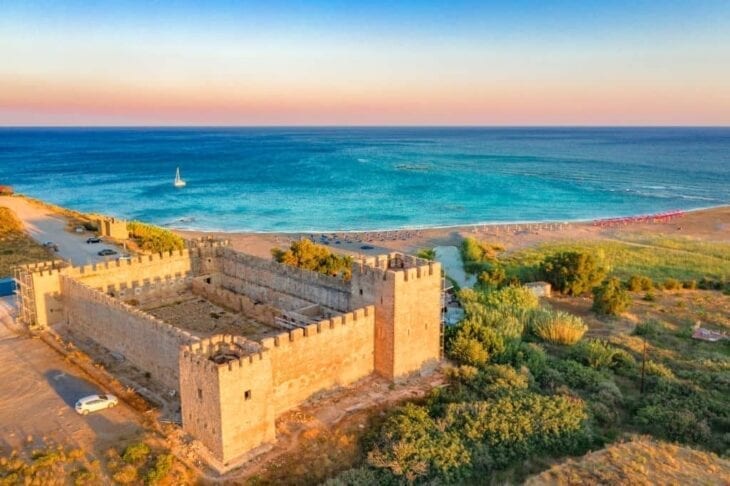
Frangokastello Fortress is renowned for the mysterious Drosoulites, or “Dew Men”, phenomenon. Legend holds that in late May or early June, shadowy figures appear at dawn, marching toward the sea. These apparitions, believed to be the ghosts of Dalianis’ soldiers, are visible for about 10 minutes when the sea is calm and the air is moist.
Frangokastello Fortress is located near Frangokastello Beach, providing easy access for visitors and offering views of the Libyan Sea and surrounding landscape. The best times to visit are in spring (April-May) and fall (September-October), when the weather is mild and crowds are lighter. Early morning visits are recommended for those hoping to witness the Drosoulites phenomenon.
Dining options near Frangokastello Fortress include Fata Morgana Frangokastello, Kali Kardia Frangokastello Taverna, and Flisvos Restaurant. Accommodation options range from simple rooms to apartments, with choices like Monachus Monachus Hotel, Coral Hotel Frangokastello and Flisvos Apartments.
The weather near Frangokastello is pleasant with temperatures from 20 to 25°C in spring and fall, peak warmth and dryness in July, and the wettest conditions in January.
The fortress, though no longer of military importance, endures as a significant historical monument and popular tourist attraction. Its dramatic setting, rich history, and mysterious legends make it a compelling destination in Crete.
3. Fortezza Fortress
The Fortezza in Rethymno, Crete, is a prominent Venetian fortress built in the 16th century, dominating the city’s skyline from Paleokastro hill. Fortezza was initially housing the ancient citadel of Rithimna and the Temple of Artemis Rokkea. It includes four main bastions: St. Luke, St. Elijah, St. Paul, and St. Nicholas. The construction of the Fortezza Castle began on Thursday, September 3, 1573 and finished by 1580 as Crete became a key Venetian stronghold after Cyprus fell to the Ottomans. Despite its solid structure, the fortress, built with the labor of over 107,000 Cretans and 40,000 animals, ultimately fell to the Ottomans in 1646.
Fortezza Castle’s history dates back to the 13th century AD, during the Second Byzantine Period, when the “Castrum Rethemi” or Paleokastro (“Old Castle”) was built. At this time, Venetians had established settlements on Crete, with Rethymnon serving as their headquarters between Heraklion and Chania. The first major destruction of the old castle occurred in the early 13th century, led by the Genoese pirate Enrico Pescatore. Other significant events shaped Crete during the first half of the 16th century.
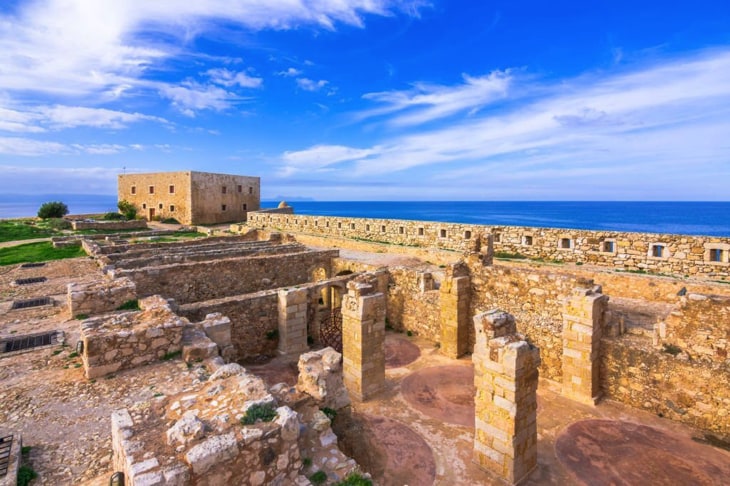
The walls of Fortezza Castle extend 1.307 metres (4.288 feet). Inside, visitors can explore the Mosque of Sultan Ibrahim (formerly the Cathedral of St. Nicholas), ancient barracks and storage rooms, the Erofyli outdoor theatre, multiple water cisterns, and the Archaeological Museum located in the Ottoman ravelin.
Fortezza Castle in Rethymno, Crete, operates from 8:00 AM to 8:00 PM during high season (June-September) and from 8:00 AM to 5:00 PM in low season (October-May), with an entry fee of 4 € (£3.46, $4.24). Early morning or late afternoon visits are ideal to avoid midday heat, while sunset offers stunning views over Rethymno and the Mediterranean. Spring and autumn provide pleasant weather and smaller crowds. Guided tours and informational brochures on the fortress’s history and architecture enhance the visitor experience.
Since the 1990s, the fortress has undergone extensive restoration and is now managed by the Ministry of Culture and Sports. Although many residential buildings within the fortress were demolished after World War II, the main structure remains well-preserved and stands as one of Crete’s most important historical monuments.
4. Kales Fortress
Kales Fortress, a historic Venetian fortification, is the only remaining fortress within an urban center in southern Crete, marking Ierapetra’s landscape. Kales Fortress, located at Ierapetra’s southern port, was designed to protect the harbor and monitor potential enemy ships, offering panoramic views of Ierapetra town, harbor, and the Libyan Sea.
Kales fortress has a centuries-long history, with its construction possibly begun by Genoese pirate Enrico Pescatore in 1212, who sold it shortly afterward to the Venetians. The first documented mention of Kales appears in 1307 in Venetian Senate records. In 1508, an earthquake caused major damage, but Venetian noble Francesco Morosini reinforced it in 1626. By 1647, the Turks had seized control, integrating Kales into their defence network; its name derives from the Turkish “koules”, meaning “tower” or “fortress”. Architecturally, Kales has a pentagonal layout with high walls and five bastions, built using local stone, showcasing Venetian and Ottoman styles, and featuring a large courtyard, church, cistern, and storage rooms.
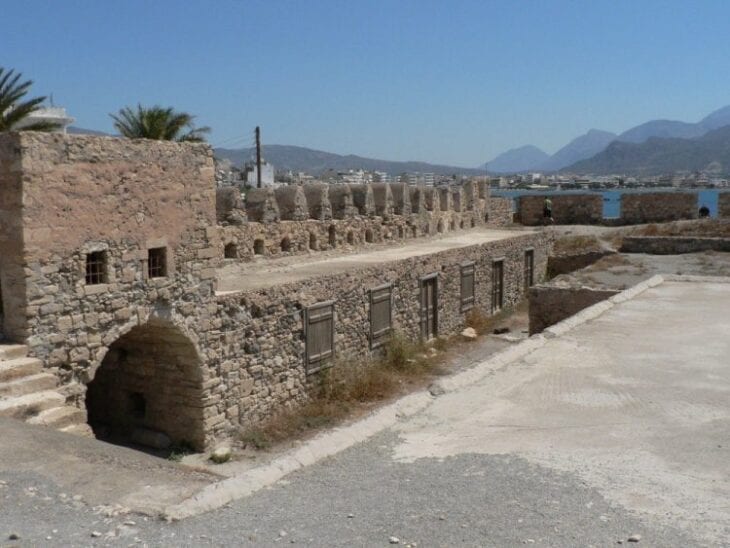
Today, the restored Kales fortress serves several functions as it hosts cultural events organised by the municipality. It houses a small museum displaying its history and architecture, and allows visitors to explore the structure and enjoy panoramic views.
Visitors can access Kales fortress year-round, but the best months for sightseeing are May to June or September to October, when Ierapetra and Crete are less crowded and temperatures are moderate.
5. Spinalonga Castle
Spinalonga Castle is a historic fortress located on a small rocky island in the Gulf of Elounda, northeastern Crete, near the town of Plaka in the Lasithi region. Spinalonga island spans 85,000 square metres and features steep cliffs on its northern side. It was originally fortified in the Hellenistic period when the Venetians constructed a powerful fortress on Spinalonga in the 16th century, using designs by engineer Genese Bressani in 1578, who armed it with 35 cannons. Despite the Ottoman conquest of Crete, Spinalonga remained under Venetian control until 1715.
The island of Spinalonga served diverse roles over time: a refuge for Muslim families during Ottoman rule, a commercial center by 1881, Greece’s official leper colony from 1903 to 1957, and was lastly inhabited by a priest until 1962.
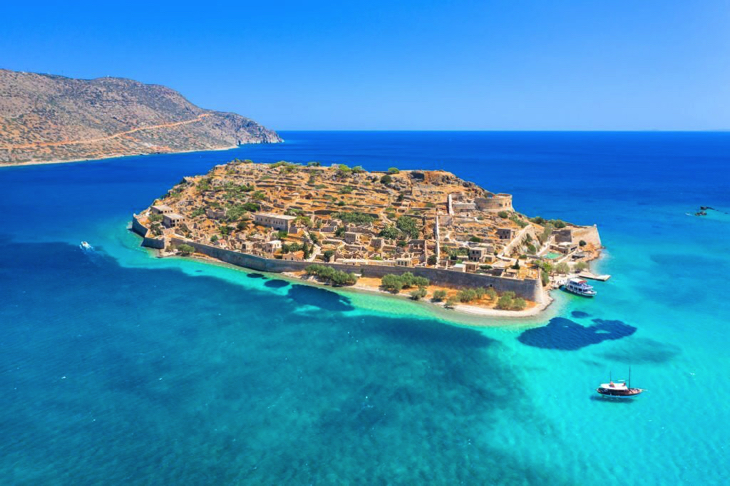
Spinalonga Castle is open daily from April to October, 8:00 AM–6:00 PM, and by request only during winter months (November–March). Entry costs 8 € (£6.91, $8.49) for adults and 4 € (£3.46, $4.24) for reduced tickets, with a combined ticket option at 15 € (£12.96, $15.92) valid for three days, granting access to additional archaeological sites. Regular boat services to Spinalonga depart from Plaka at 10 € (£8.64, $10.61) for a 10-minute journey, from Elounda at 12 € (£10.37, $12.74) for a 20-minute journey, and from Agios Nikolaos at 16 € (£13.82, $16.97).
The best time to visit Spinalonga Castle is from April to June or September to October to avoid peak crowds. For visits in July and August, early morning or late afternoon provides a quieter experience. Plan for 4 hours to explore Spinalonga island and Castle itself. On-site amenities include a café, souvenir shop, toilets, and a museum featuring historical exhibits.
Nearby dining options for visitors to Spinalonga include several upscale restaurants in Elounda, such as Il Borro Tuscan Bistro, Blue Lagoon Restaurant, Thalassa Restaurant, and Dionysos Restaurant. The island’s peripheral path is accessible for visitors with disabilities, but comfortable shoes are advised due to potentially slippery paths. Additionally, bring sun protection, water, and swimming gear if you plan to swim.
Guided tours of Spinalonga Castle are available through the official tourist guides association, covering key points of interest such as the main settlement, hospital, Church of St. George, cemetery, and Market Street with restored Ottoman-era shops. Spinalonga ranks as the second most visited tourist site in Crete and the sixth in Greece, attracting visitors for its blend of Venetian architecture, Ottoman influence, and leper colony history, making it a rich destination for history and architecture enthusiasts.
6. Koules Fortress
Koules Fortress, also called Rocca a Mare, is a Venetian fortress and a major landmark in Heraklion, Crete. Koules is located on the western edge of Heraklion’s old Venetian port and occupies 3,600 square metres (4,30 yd²) with two stories and 26 rooms. The Castle’s thick walls protect the harbour’s breakwater. Dating back to the 10th century, the current structure was built by the Venetians from 1523 to 1540 and later renamed Koules under Ottoman rule, serving various strategic functions.
Koules Fortress served critical military and administrative functions. Militarily, it housed cannons (18 on the ground floor and 25 on the first floor by 1630), protected Heraklion’s harbour and docks, and acted as a stronghold. Administratively, it provided residence for the governor and officers, stored food and munitions, and included a bakery, mill, and small church, essential for the fortress’s self-sufficiency.
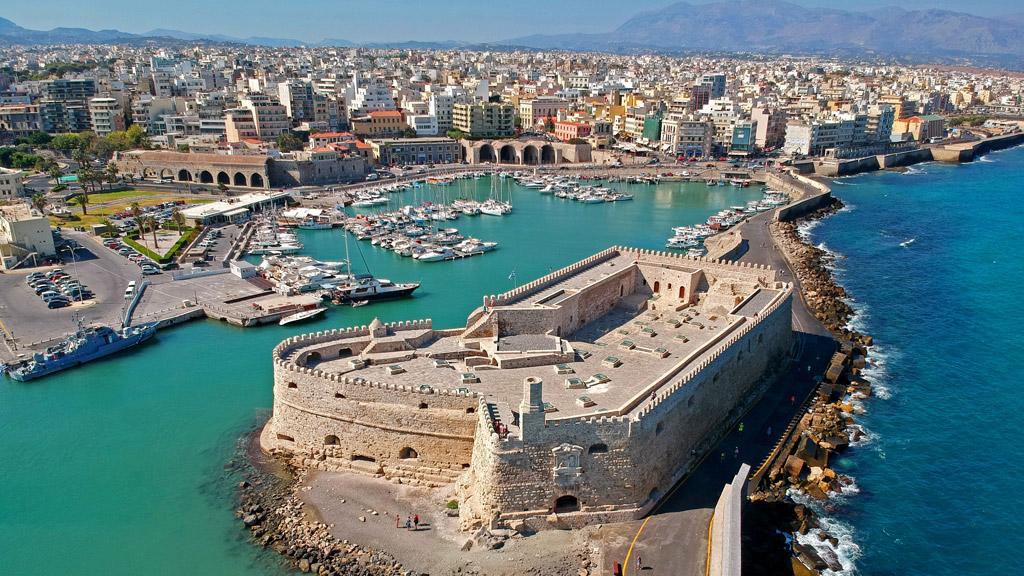
Koules Fortress is open Wednesday through Monday, closed on Tuesdays. From April to October, hours are 8:30 AM to 7:00 PM; in winter, 8:30 AM to 3:00 PM. The cost to enter Koules Fortress is 4 € (£3.46, $4.24), with a reduced rate of 2 € (£1.73, $2.12). The best time to visit Koules Fortress is early morning or late afternoon during weekdays in the summer (June-August) to avoid crowds.
Inside Koules Fortress, visitors encounter historical exhibitions, ancient weapons, artefacts, underground dungeons, and panoramic views from the top walls. The fortress includes three marble reliefs depicting Venice’s symbol, the Winged Lion of St. Mark, on various facades.
Today, Koules Fortress functions as a historical monument and museum, hosting art exhibitions and performances. The structure faces ongoing challenges from sea damage, necessitating continuous maintenance and repairs to preserve its masonry and foundations.
How is the Crete Historical Map?
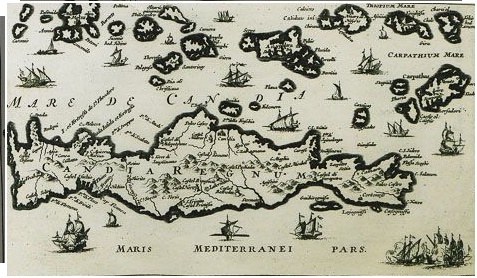 The historical map of Crete shows the historical places in Crete and their old names. Crete has many historical places and three main places are rich in history. These historical places play a big part in the present life of the people of Crete. These are the IDA Monte, Rethymno and Candia.
The historical map of Crete shows the historical places in Crete and their old names. Crete has many historical places and three main places are rich in history. These historical places play a big part in the present life of the people of Crete. These are the IDA Monte, Rethymno and Candia.
What are the names of places in Crete from History?
Listed below are the names of places in Crete from History.
- Labyrinthos. The Labyrinth is known to have been in the Palace of Knossos, built around 1950 BCE. The ruins stand near the city of Heraklion on the north coast of Crete. According to some archaeologists, novelists, and documentary-makers, claims that the Cretan Labyrinth was a real place. However, there is no conclusive evidence that a labyrinth existed in Knossos. Even though it never existed, it will remain in its role as a place of fear, wonder, and enlightenment, as a reference in popular culture featuring the Minotaur and its lair.
- Mount Ida. IDA Monte, commonly known as Mt. Ida, is the highest mountain on Crete. It is also called Psiloritis Ida. It is located in the Rethymno regional unit. In Greek Mythology, Ida was sacred to the Titaness Rhea. Today, Mount Ida is one of the famous tourist spots in Crete.
- Rethymno. Rethymnno is situated on the bay, anciently called Amphimale. It is located on a short point on the northern coast of Crete, halfway between Candia (Iraklion), to the east and Chania to the west. Today, people can still visit the Rethymo, now known as Rethymno.
- Gortina. Gortina is also known as Gortyn, was a town in Ancient Crete. It appears in the Homeric poems and afterwards became Gortyna. It was originally called Larissa and Cremnia or Kremnia, according to Stephanus of Byzantium. The site of Gortyna is at modern Gortyn. The extensive ruins of the ancient town remain, and it is a major archaeological site in Crete.
- Candia. Kingdom of Candia was the official name of Crete during the island’s period as an overseas colony of the Republic of Venice. Venice had a long history of trade contacts with Crete. Crete was awarded to Boniface of Montferrat but failed to enforce his control over the island, and soon sold his rights to Venice. At present, Crete is the most populous of the Greek islands. Tourists frequently visit the island because of its diverse and vibrant land enriched with ancient ruins, and historical past.
- Altemura. Twelve miles from Lyttus, on the sea coast, are the remains of Chersonesus, now called Chironisso. From the walls and position of the city, it is sometimes called Altemura. It is a small city, not more than two miles in a circuit. It has amphitheatres and other splendid buildings. Furthermore, it used to have a port but is now destroyed. The site of Chersonesus is located near modern Cape Karavoutas or Koutoulos.
- Bicorna. Apokoronas is one of the five provinces of Chania prefecture in the Northeastern part. During ancient times, the word “Apokoronas” was not at all mentioned. From time to time, there have been other names, like “Bicorna” and “Bicorno”. There is evidence proving that there has been a human presence spotted in Apokoronas since the Neolithic period.
Which Landmarks from Crete should I visit first?
When visiting Crete for the first time, it is best to visit Heraklion first, where the famous Knossos Palace is located. The Palace of Knossos is very easy to access, either by car or bus. It is popular among tourists because of its easy accessibility. It is just a 15-minute car drive from the main bus station at the port of Heraklion. If travelling by bus, take bus number 2. If driving a rental car, take the Agio Nikolaos Highway, and it will lead directly from Chania to Heraklion. The duration will take around 2 hours.
What are the Crete Archaeological Museums?
Listed below are the Crete Archaeological museums.
- Heraklion Archaeological Museums. It is one of the oldest and most important museums in Greece. The Heraklion Archaeological Museum is located in the town centre and is designed by Architect Patroklos Karantinos. It prides itself on its Minoan collection that includes masterpieces of Minoan art.
- Archaeological Museum of Agios Nikolaos. The Archaeological Museum of Agios Nikolaos was founded in 1969. It is considered one of the most significant in Crete. It has collections of very significant archaeological findings from the entire region of eastern Crete. Furthermore, it houses more than 1,500 pots, including the oldest gold and bronze findings in Crete.
- Archaeological Museum of Chania. The Archaeological Museum of Chania is located on the outskirts of Chalepa, the most predominant historic district of Chania after the Venetian urban centre. The museum was designed by Architect Theofanis Bobotis and partners. The Archaeological Museum of Chania is set out in three galleries on the ground floor and one on the upper floor. The permanent exhibition features the rich archaeological heritage of Chania over time. These artefacts highlight aspects of religion, war, entertainment, and trade.
- Museum of Ancient Eleutherna. The Museum of Ancient Eleutherna is situated on the northwest foot of Mt. Ida, approximately 30 kilometres (18.6 miles) south of Rethymno. It is the first archaeological site museum on the island of Crete. The small museum was created to house the results of excavations in the ancient city of Eleutherna for 30 years.
- Archaeological Museum of Rethymno. One of the Archaeological Museums in Crete is The archaeological museum of Rethymno, located in the heart of the old town, near the harbour and the local points of interest. It is housed in the Saint Francis church, which was founded in the 16th century. The museum features amazing exhibits from the post of Rethymno that date from the Palaeolithic era, such as tools, and to the Venetian period like the gold coin of Doge Francesco Molin from 1646.
- Archaeological Museum of Sitia. One of the best museums in Crete is the Archaeological Museum of Sitia. It opened its doors to the public in 1984. The museum was founded by the famous Cretan archaeologist Nikos Papadakis. The key exhibition area is to the left of the entrance and features exhibits with Greek and English descriptions. The most significant group of archaeological treasures presented in the museum is that of Zakros, which holds many finds from the Minoan period from the palace of Kato Zakros.
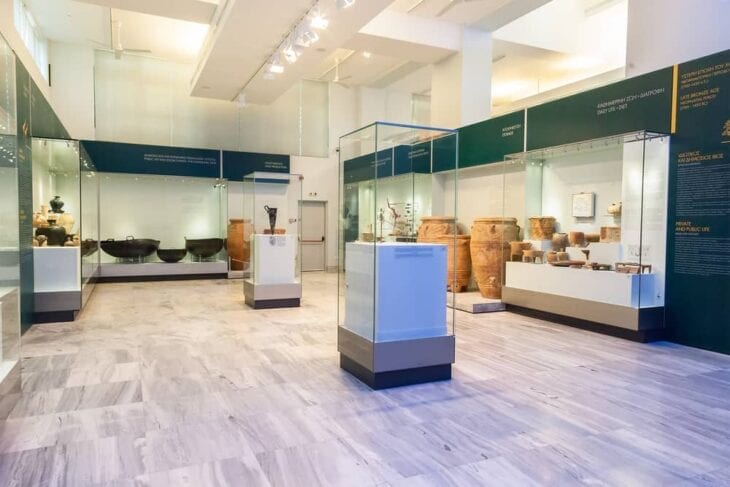
What are the other ancient cities in Crete?
Listed below are the other ancient cities in Crete.
- Archanes. Achanes Temenos is located 15 kilometres (9.3 miles) south of Heraklion, and 10 kilometres (6.2 miles) south of Knossos. It never had its currency, but there were coins of Knossos that have been found in the area. Archanes is one of the most important areas in Minoan archaeology. Archanes was the linchpin between Knossos, the temple on top of Mount Giouchtas, and the cemetery of Phourni, where the royal family were buried.
- Aina or Ainaon City. It was a short-lived and unimportant town of Crete in the 1st-2nd century BC, in the Gortys area. There are bronze coins from 1963 found in Beis location, in Kainourgio Kastelli village, Heraklion prefecture.
- Akytos. Akytos is now called Thodorou or Agioi Theodoroi, and Toullouros. Its present name was derived from the chapel of Saint Theodores, of which now only the foundations remain. Akytos became famous in the Venetian period.
- Viannos. Ano Viannos, Biannos or Biennos is located below Epano Viannos village. The city took its name from its founder Biennos or from the word Bia, which means violence, and struggle, that took place there among the sons of Poseidon and Ares, Otos, and Efialtes. Biannos was independent. The city had its coins.
- Herronisos or Chersonisos. It was a powerful city of Crete on the northern coast of the island. The city was established by the children of the citizens of Imbros, and Lesbos islands. Their mothers were Athenians, who had been abducted. Then those children married Spartan women, and they were exiled from Sparta. They took money and ships. Those residents brought with them statues of Artemis.
- Cydonia. Cydonia was the third-largest city in Crete. It was located where the city of Chania is now built. According to stories, Minos or YCdon, son of Apollo or Hermes and Acacallis, daughter of Minos, or son of Tegeates, was the founder of the city. Cydonia is one of the Ancient Cities of Crete.
- Itanos. Ermoupolis Sitias. It was located north by east of Toplou monastery at Sidero Cape. The city blossomed in the historic Greek and Greco-Roman periods. The city was established during the Prehellenic period. The city had its coins and the public buildings were covered with marble.
- Kamara. The city was established during the Archaic period. They only had one currency, and the coins had the image of Eileithyia or Artemis, and Hermes with the word Lation. The citizens were called Kamarites or Kamaraios.
- Kaunos or Kaudos. The island of Gavdos. The area has been declared an archaeological site. The earlier relics on the island belong to the Neolithic period. There has been evidence that Kaudos was once inhabited because up to now there were spotted 63 archaeological locations.
- Keraia. Keraia was an autonomous city of Crete. The citizens were called Keraites or Keretes. Their coins have images of Artemis and Apollo. The city was one of those that signed the decree with Eumenes B’.
How is the transportation in Crete?
Due to the popularity of the island of Crete as a tourist destination, there is regular transportation on the island from one place to another. There are buses available both in the urban and rural areas of Crete. Taxis in Crete can also be found anywhere, particularly in larger towns. Motorbikes and car rental companies are prominent in Crete. Most of them are located in airports, bus stations, and almost all towns. The road network in Crete connects all major towns and tourist spots on the island. In some other mountain regions, the roads are winding and can be narrow. The transportation in Crete is very convenient for tourists. There are many choices of modes of transportation to choose from. Although some roads are quite challenging in the mountain regions. Some road signs are visible but lacking in rural areas. Renting a car is always advisable when exploring the island of Crete. It provides more flexibility and faster travelling time.
How to visit Crete Landmarks by car rental?
One way of visiting the beautiful landmarks of Crete is by renting a car. One can easily book Car Rental Crete online to avail of the service. Indicate the chosen date and location on the website. Then choose the best car and if one wishes to add more additional services it is possible. Then go ahead and checkout. It’s as easy as that.
Is it possible to use bus tours for Crete Landmarks?
Yes, it is possible to use bus tours for Crete Landmarks. These bus tours also provide a free city map and usually have 10 stops around the city. They provide hotel pickup and drop-off. Bus tours also have audio commentary available in eight languages. If travelling in groups, taking a bus tour is more convenient and easy. A group of 10 tourists can be accommodated inside the tour bus.
Last updated on January 5th, 2025












 The route will start in the lovely town of Sitia, and set off on the rural route (“EO” or “Epar. Od ”) Sitias-Palekastrou towards the east along the sea. From here, take a 12 km detour to Vai, a famous beach with clear waters and fine sands. Passing through Palekastro, will lead to Ano Zakros. From there, along the rural route (”EO” or “Epar. Od”) Zirou-Palaikastrou, the road rises again, giving way to vistas of the Libyan sea afar. After passing Ziros, the route will lead to Chandras, a small village of stone houses. Descending towards the southern coast, the Libyan sea will be visible again in dramatic view. The area around Ierapetra is the market basket of Greece.
The route will start in the lovely town of Sitia, and set off on the rural route (“EO” or “Epar. Od ”) Sitias-Palekastrou towards the east along the sea. From here, take a 12 km detour to Vai, a famous beach with clear waters and fine sands. Passing through Palekastro, will lead to Ano Zakros. From there, along the rural route (”EO” or “Epar. Od”) Zirou-Palaikastrou, the road rises again, giving way to vistas of the Libyan sea afar. After passing Ziros, the route will lead to Chandras, a small village of stone houses. Descending towards the southern coast, the Libyan sea will be visible again in dramatic view. The area around Ierapetra is the market basket of Greece.